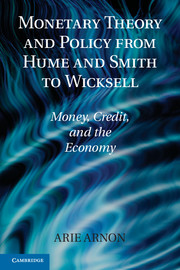Book contents
- Frontmatter
- Dedication
- Contents
- List of Illustrations
- List of Tables
- Preface
- Introduction
- Part one Analytical and Historical Foundations
- Part two Debating Monetary Theory under Inconvertibility
- Part three Debating
- Part four The Road to Defensive Central Banking
- 14 Bagehot and a New Conventional Wisdom
- 15 Does Karl Marx Fit In?
- 16 Marshall’s (Oral) Monetary Tradition and Bimetallism
- Part five A New Beginning
- Bibliography
- Author Index
- Subject Index
16 - Marshall’s (Oral) Monetary Tradition and Bimetallism
Published online by Cambridge University Press: 05 July 2014
- Frontmatter
- Dedication
- Contents
- List of Illustrations
- List of Tables
- Preface
- Introduction
- Part one Analytical and Historical Foundations
- Part two Debating Monetary Theory under Inconvertibility
- Part three Debating
- Part four The Road to Defensive Central Banking
- 14 Bagehot and a New Conventional Wisdom
- 15 Does Karl Marx Fit In?
- 16 Marshall’s (Oral) Monetary Tradition and Bimetallism
- Part five A New Beginning
- Bibliography
- Author Index
- Subject Index
Summary
Introduction
Alfred Marshall (1842–1924) contributed to the rise and canonical status of the new, marginalist tradition in economics after the 1870s; more than any other individual, he helped in many ways to create modern, professional economics in Cambridge, England, in the last quarter of the nineteenth century. His major book, The Principles of Economics (1890) – not primarily devoted to monetary issues – soon inherited the canonical status of J. S. Mill’s classic treatise and remained the major text of marginalism for many years. Marshall’s contributions to the fields of monetary theory and policy were also exceptional. This, in spite of the well-publicized and curious fact that Marshall’s monetary thinking was mainly passed down in the form of an oral tradition; his first published book on monetary issues did not appear until 1923, when he was over eighty years old. In the meantime, the Cambridge oral tradition that he shaped had been written down and published by others. Marshall became interested in monetary subjects early in his career; long before his book on money finally appeared, he had expounded original and well-advocated ideas; lectured often on monetary subjects; gave evidence before official committees of inquiry; and established the Cambridge oral tradition on money.
Historians of economic thought have studied Marshall’s early monetary thinking mainly through two early texts that were published only in 1975. These texts prove that the oral tradition was not only influential, but well thought out and even formulated in written, though not published, form early on. These early texts can help confirm what the oral tradition was in the early years, at the time when the British monetary orthodoxy of the 1870s took shape (see our Chapter 14). Our focus, however, is on the influence of Marshall’s oral tradition on later thinkers; therefore, this chapter will emphasize those of Marshall’s monetary views that were accessible to interested scholars in the 1880s, such as Wicksell.
- Type
- Chapter
- Information
- Monetary Theory and Policy from Hume and Smith to WicksellMoney, Credit, and the Economy, pp. 330 - 340Publisher: Cambridge University PressPrint publication year: 2010

